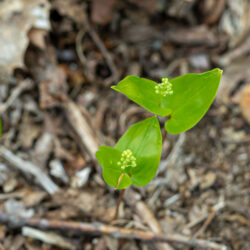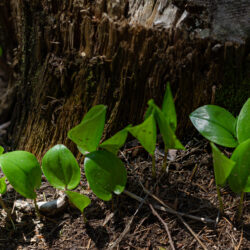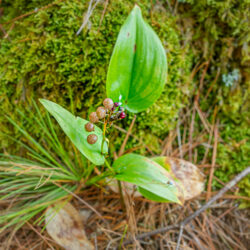Etymology
Maianthemum is Latin for May blossom; canadense is Greek for northern.
Native Habitat
Dry or moist woods.
Garden Uses
A pleasant groundcover for woodland and shade gardens. A winter cover of leaves or needles aids survival.
Overview
Rising less than 6 inches, this small perennial herb blankets many mossy, acidic, forested areas of the northeastern US. Its rhizomatous spread results in the carpet-like colonies often seen on shady hillocks and depressions.
Leaves and Stems
The leaves and stems of this plant exhibit some of the earliest growth in the spring, emerging as tight, straight green coils. These open to bright green, alternate, simple, shiny, and oval to heart-shaped leaves, generally measuring 3 inches in length and about 2 in width. Stems are upright, and can be straight to wavy. Not all of the stems will flower. The sterile stems typically have 1 leaf, while those that flower have 2-3 leaves with one terminal flower cluster.
Flowers
Blooms include clusters (racemes) 1 to 1-1/2 inches long, made up of 3/8 inch, white, star-shaped flowers, each with 4 petals (note: some sources say 2 petals), 2 sepals, and 4 prominent stamen, which provide the star-like appearance. This configuration is very unlike the 3-3-6 pattern seen in members of the lily family.
Fruit/Seed
Flowering is followed by a small, pale green berry, which becomes mottled with red, and gradually ripens to dark red by late summer. Each berry contains 2 or more seeds.
Wildlife Associates
Berries of this plant are attractive to birds.
Propagation
Rhizomatous spread allows for easy division, preferably in the autumn after leaves have yellowed. Divide each rhizome into 2 inch pieces, plant 6 inches apart, 1/2 inch deep, and mulch. Ripe berries can also be collected, pulp removed, and seeds planted immediately outdoors.
Ethnobotanical Uses
Some Native Americans reportedly used this plant to soothe headaches and sore throats.
Garden Location
Performance Hall Garden (see garden map)
Sources
Lady Bird Johnson Wildflower Center
Plant Profile by Kate O’Dell



